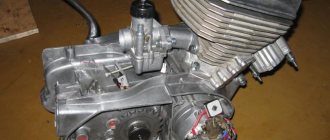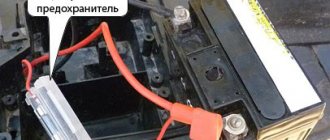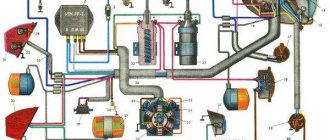Generator G-11A of the Ural motorcycle.
Checking and adjusting the G-11A generator of the Ural motorcycle can be done in different ways. Serviceability is monitored by a warning light, and if for some reason it is missing or burnt out, then you need to remove one of the wires from the battery terminal at medium engine speeds. If the engine continues to run, then the generator is working.
The generator can also be checked by connecting one end of the wire to a portable lamp to ground, and the other to terminal I of the relay-regulator (in this case, the wires must be disconnected from terminals Ш and И). Then give the engine medium speed, and if the portable lamp lights up, then the generator is working.
Generator G-11A: 1 — drive gear; 2 — oil seal; 3 - armature winding; 4 — front cover; 5 — body; 6 - wooden wedge; 7 - armature core; 8 — pole shoe; 9 — excitation winding; 10 — brush; 11 — brush spring; 12 — contact bolts; 13 - ball bearing; 14 — bearing cover; 15 - coupling bolt; 16 — armature shaft; 17 — brush holder; 18 - collector; 19 — cover; 20 - protective tape.
Characteristics of the G-11 A electric generator → more details.
Adjusting gear mesh
If the generator has been removed, then when installing it in place it is necessary to adjust the engagement of its drive gears.
The procedure for adjusting the G-11 A generator of the Ural motorcycle is as follows: - install it in place in the engine crankcase; — start the engine and listen to the noise the drive makes; — if the drive is noisy, you need to increase the gap between the gears; — and if you hear a knock, reduce the gap; — loosen the bolt of the tightening tape and, turning the generator by the housing, set by ear the required gap between the gears; — secure the tensioning tape and check the noise of the gears again.
Return to contents — ↑
Relay-regulator PP-330, troubleshooting
After I determined that the generator was working. I started searching for the faulty relay regulator. To understand the principle of its operation, a little theory.
Read also: Electronic ignition system is
I will not describe in detail the operation of the relay regulator; I will describe the problem that I fixed. This problem was in two relay regulators, and the reason for it was that due to a long time of inactivity of the contacts, the carbon contacts of the R.N. coil. (in the diagram above) oxidized and did not pass current.
During normal operation of all equipment, the process is as follows. When you turn the key S1: “+” from the battery is supplied to the ignition coil and to the V3 contact of the relay regulator. In the relay, power from the VZ contact passes through the RN coil. and to contact “Ш” of the generator, a rotor winding is connected to it. Thus the armature is excited by the battery. When the engine speed increases, at contact "
» alternating voltage appears, the R.KL relay is activated, and the control lamp turns off.
Also, as the speed increases, the voltage at the “+” contact of the generator also increases. It is connected to the R.N. relay, when a certain voltage threshold is reached, the relay is activated and the power goes not directly through the relay coil with a small resistance, but through the load resistances, thereby reducing the voltage on the rotor. By reducing the voltage level on the rotor, the current strength decreases, and, accordingly, the magnetic force of the rotor decreases. Which leads to a decrease in voltage at the outputs of the stator windings. When the voltage in the relay R.N. decreases The relay holding current drops, thereby the R.N. contacts. return to their original state and the process repeats.
If the generator is spun up without a relay-regulator and a load, but the armature is excited, then as the speed increases, the EMF in the stator windings will increase, which theoretically can damage them (break through the insulation). Therefore, it is prohibited to turn on and spin up the G 424 generator without a load.
In my case, the carbon contacts of the R.N. relay were oxidized , thereby providing insufficient voltage to the rotor to excite it. The generator simply did not produce voltage.
Simply cleaning the contacts solved the problem .
Reasons for digging, no battery charging (runs out when working)
What we have, we bought a used generator for 250 rubles. mate part from the Internet on checking the generator - um, a curve, to be honest. what was the output and how to check. we remove the generator - this makes it easier to remove the diode bridge, since without removal, if the central contact is broken, the diode bridge supposedly works, but in reality it does not. as we check already under cut:
1. take + from the battery and connect it with a wire to one of the braided terminals from the generator with the diode bridge removed, and - from the battery through the light bulb (control) we touch one of the other 2 terminals, then the other lamp should light up 2. take + from the battery and We connect it with a wire to one of the braided terminals from the generator with the diode bridge removed, and - from the battery through the light bulb (control) we touch the generator housing; the lamp should not light up. 3. We take the diode bridge and in the ringing mode we attach one probe to the mark to which the output from the bridge is screwed and we ring at the place where one of the terminals from the generator is connected, everything should ring in one direction with readings of 450-490 ohms, in the other it should not ring.
in my case, my generator had a breakdown of the central contact to the housing and a live diode bridge; the generator I purchased had a dead diode bridge.
Read also: Car windows sweat, what to do
I didn’t want to continue to trust the original relay regulator and bought a relay from a VAZ with a control lamp for 110 rubles and a relay for the lamp on the tidy to work for 90 rubles.
Installing a Zhiguli relay regulator on the Dnieper or Ural for example 121.3702 for 12V You will need to change the contact pairs on the wires. You will also need a normally open or closed relay (the control light will light up when there is no charge or vice versa when it appears)
We connect the wire that went to the VZ on the PP330 (the terminal on top) to connector 15 (if you install a relay, you will need a tap from this contact to the relay)
We connect the wire that went to the terminal (Ш) to the connector (67). (make sure wires Ш and
you are not mixed up (disconnect the wires w and
from the generator and ring them, otherwise they will suddenly be confused or shorted to ground somewhere. )
We attach the mass to the metal plate of the electric relay.
There are 2 wires left (they are needed for the control lamp on the tidy, you don’t have to connect them and just isolate them.
We connect the relay: We connect the wire that went to the terminal (change) PP 330 to the connector (86). We connect the wire that went to the terminal (LC) to the connector (87). We dealt with the wires hanging in the air. We connect connector (85) to ground with a separate wire. We connect connector 30 to the wire that goes to connector (15) of the electronic relay, which is also positive from the ignition switch.
Everything works and makes me happy, we continue to work, by the way, can anyone recommend a normal box that can be installed under modern fuses? I want to replace the standard one.
Good afternoon or evening, everyone, with the beginning of the season, in general, I have the same problem today I went for a ride, drove a couple of kilometers, and one boiler failed, drove one to the garage, changed the spark plug, started it and noticed that all the lamps on the panel are very dimly lit, and when I press the throttle, they don’t start to burn brighter, I thought maybe, I turned off the engine, looked at all the contacts to see if they were tightened well, everything was fine, I started it again, and again the same story. I remove the wire from the Akum and the engine immediately stalls, I know that the standard G does not produce at low speeds, I start it again, give it more gas, I drop it, it stalls again, I thought the RR is full, I change it, clean all the contacts, change the G. When I start it up the same story, the low/high light lamp lights up dimly and with an increase in speed, there are no changes. I took a multimeter and measured the 11.6 V battery, the battery holds a charge well, but for some reason it was discharged, I conclude that just recently there was such a problem, the electrolyte bubbled up in it when you gave it gas, but now there was no gas, I even then thought that it was “not “It’s good,” but he started referring to the fact that the battery was small from a Hogdov scooter, and he thought it was small in capacity and that’s why it was boiling, but the fact remains that the battery hasn’t been charged from G for a couple of days, I use it every day or every other day, and it stayed overnight not today, what could it be, RR? G?, I’m thinking of installing a RR from a VAZ, is it worth it, maybe the wiring, but there are a couple of wires in this circuit (RR - G - Akum), maybe a lock, I ask for some advice)
Read also: Analogues of spare parts by number
In the Urals I have an auto voltage regulator 121.3702 with a relay for a PC702 light bulb. I was very pleased. But it turned out that either I’m stupid or the skis don’t work. In short, the charging light only lights up when the engine is off. And I naively believed that charging now proceeds even from idle with all consumers turned on. So, after driving 700 km (mostly in the city and at a speed of 60-70 km/h), the low beam suddenly began flashing at idle. I checked the voltage with the engine off and no load - 12.5V. I started it up, turned on the low beam (xenon 35V), waited until it turned on - 9V. That's why the light disappears. So this is why I wrote all this. The charging lamp never even blinked! In general, he is lying. The battery is discharged, but the lamp still does not light up










